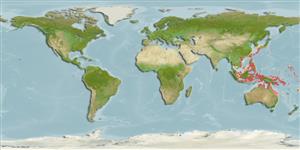>
Ovalentaria/misc (Various families in series Ovalentaria) >
Plesiopidae (Roundheads) > Plesiopinae
Etymology: Plesiops: Greek, plesios = near + Greek, ops = appearance (Ref. 45335); cephalotaenia: From the stripes on the head of the species (Ref. 27772).
Environment: milieu / climate zone / depth range / distribution range
Écologie
marin récifal; profondeur 0 - 12 m (Ref. 27772). Tropical
Western Pacific: Japan south to Australia; east to Solomon Is.
Taille / Poids / Âge
Maturity: Lm ? range ? - ? cm
Max length : 7.7 cm TL mâle / non sexé; (Ref. 90102)
Épines dorsales (Total) : 12; Rayons mous dorsaux (Total) : 6 - 7; Épines anales: 3; Rayons mous anaux: 7 - 10.
Adults occur inshore (Ref. 7300) at depths of 12 m or less in dead coral, reef flats, and on coral heads, habitats with somewhat less wave energy (Ref. 27772). Eggs are guarded by the male parent (Ref. 205).
Life cycle and mating behavior
Maturities | Reproduction | Spawnings | Egg(s) | Fecundities | Larves
Eggs are guarded by the male parent (Ref. 205).
Mooi, R.D., 1995. Revision, phylogeny, and discussion of biology and biogeography of the fish genus Plesiops (Perciformes: Plesiopsidae). Life Sci. Contrib. No. 159, 108 p. (Ref. 27772)
Statut dans la liste rouge de l'IUCN (Ref. 130435)
Menace pour l'homme
Harmless
Utilisations par l'homme
Outils
Articles particuliers
Télécharger en XML
Sources Internet
Estimates based on models
Preferred temperature (Ref.
123201): 26.2 - 29.3, mean 28.8 °C (based on 1571 cells).
Phylogenetic diversity index (Ref.
82804): PD
50 = 0.5000 [Uniqueness, from 0.5 = low to 2.0 = high].
Bayesian length-weight: a=0.00468 (0.00177 - 0.01234), b=3.18 (2.95 - 3.41), in cm total length, based on LWR estimates for this (Sub)family-body shape (Ref.
93245).
Niveau trophique (Ref.
69278): 3.4 ±0.5 se; based on size and trophs of closest relatives
Résilience (Ref.
120179): Haut, temps minimum de doublement de population inférieur à 15 mois (Preliminary K or Fecundity.).
Fishing Vulnerability (Ref.
59153): Low vulnerability (10 of 100).
Nutrients (Ref.
124155): Calcium = 168 [86, 287] mg/100g; Iron = 0.824 [0.475, 1.399] mg/100g; Protein = 18.5 [17.4, 19.6] %; Omega3 = 0.102 [0.056, 0.189] g/100g; Selenium = 20.1 [8.8, 43.0] μg/100g; VitaminA = 161 [51, 493] μg/100g; Zinc = 2.05 [1.32, 3.00] mg/100g (wet weight);
